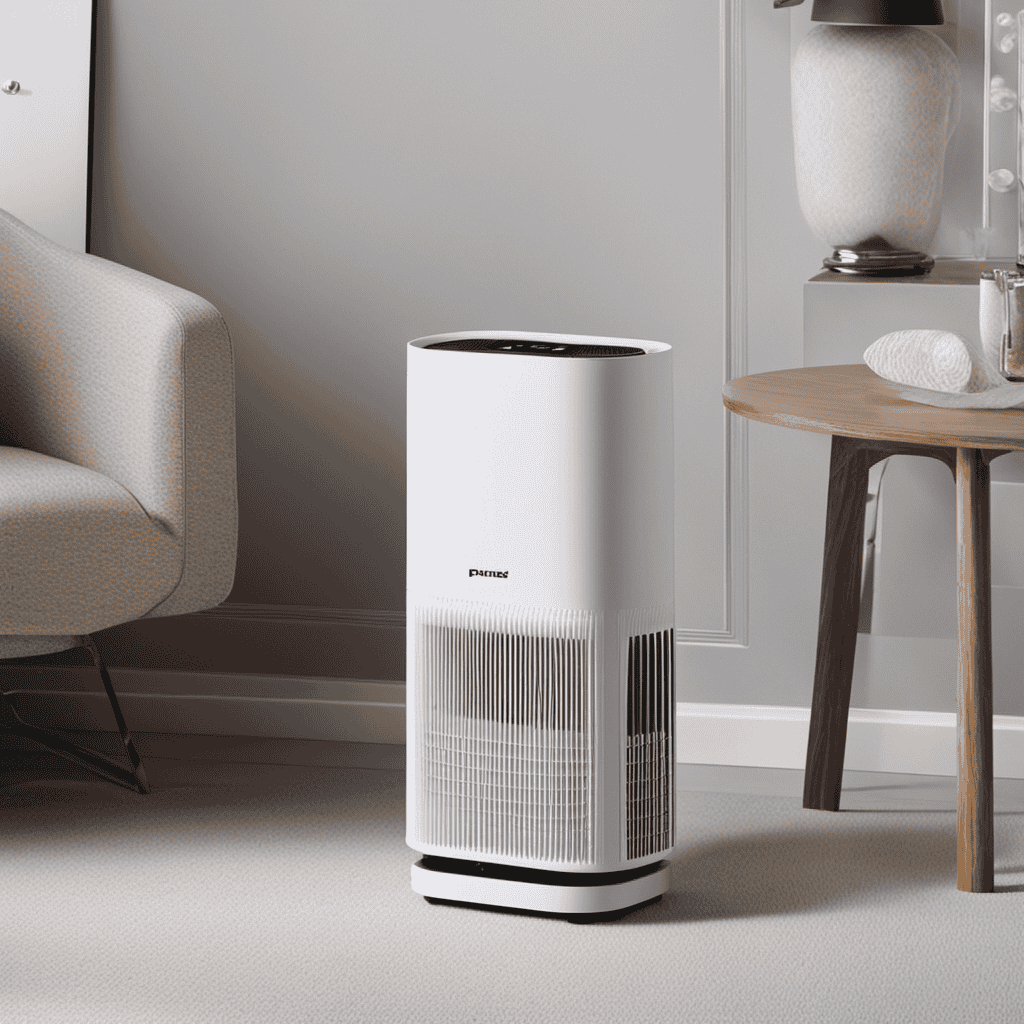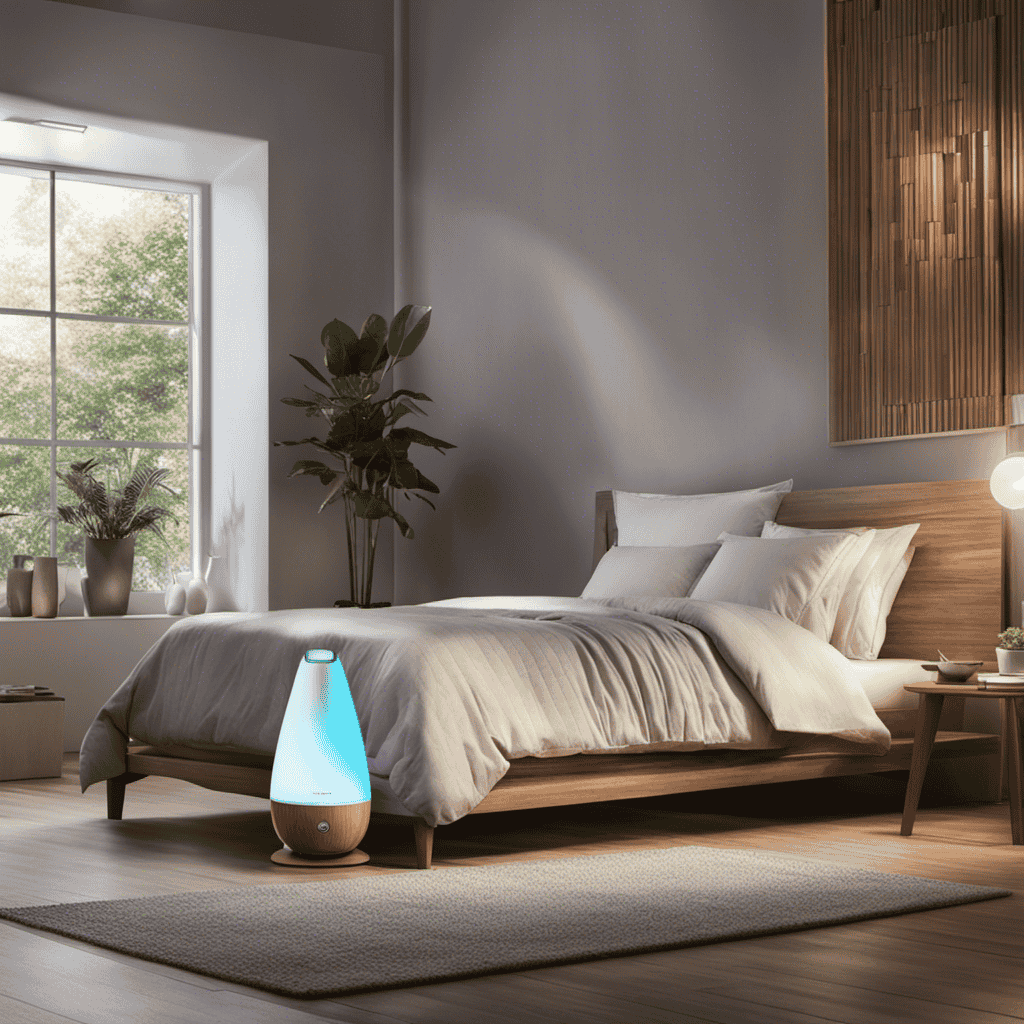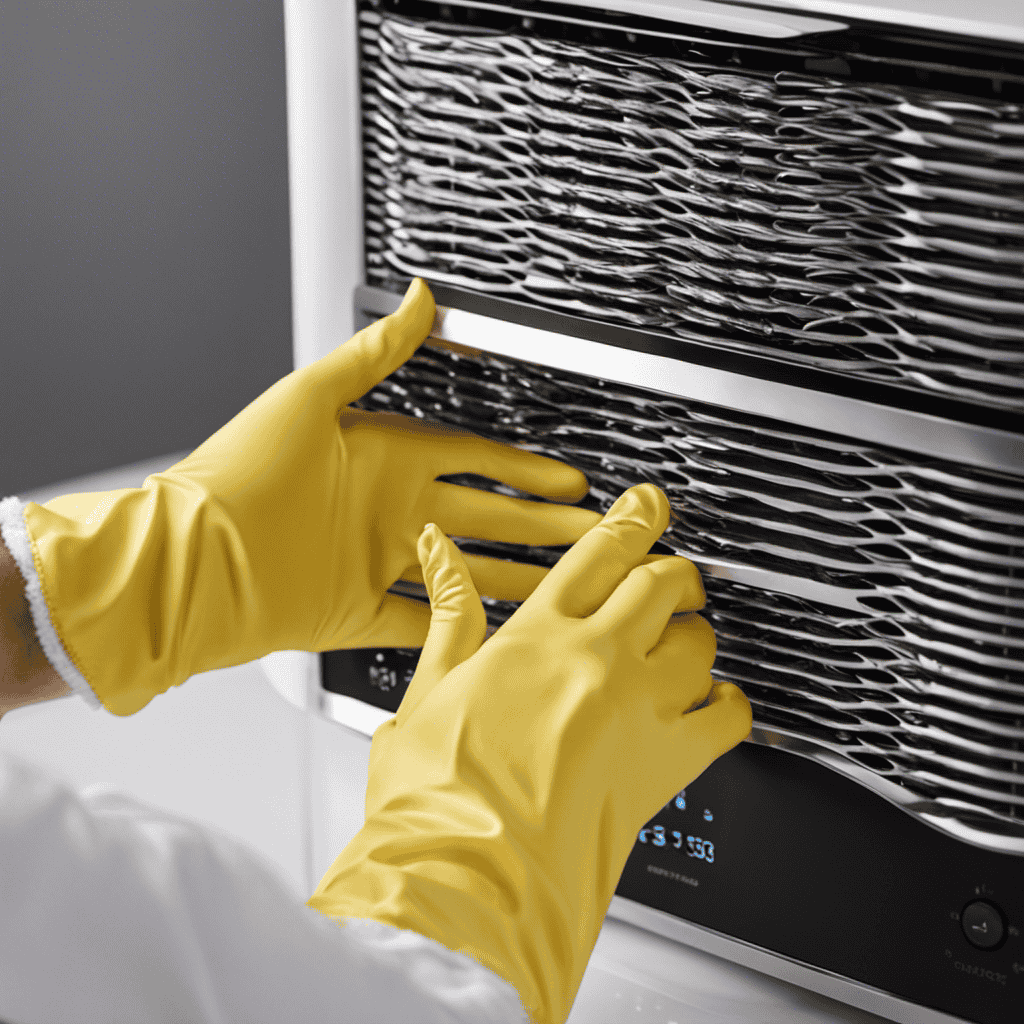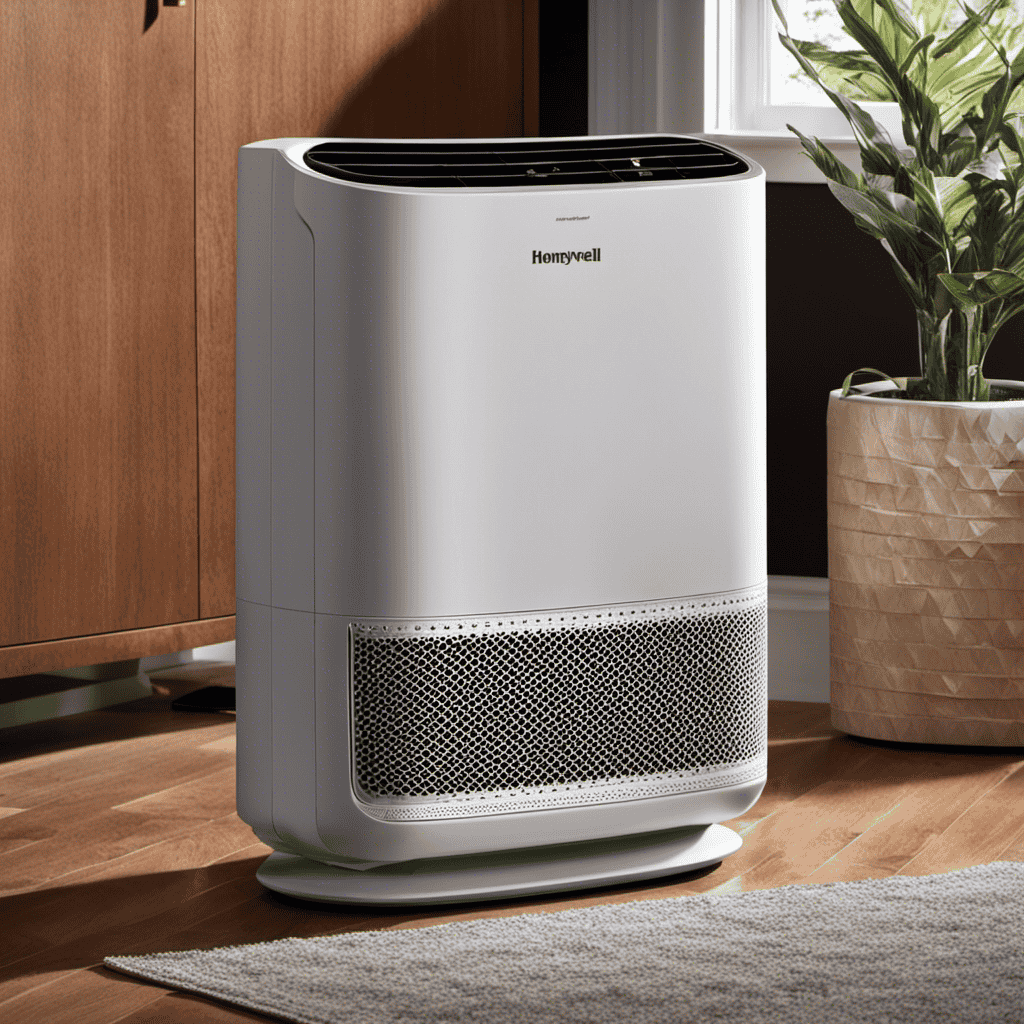When it comes to creating a comfortable and healthy living environment, I frequently contemplate whether a dehumidifier or an air purifier would be more beneficial. Both of these devices are important for enhancing indoor air quality, so it is crucial to understand their differences and advantages.
In this article, we will delve into the world of dehumidifiers and air purifiers, exploring their functions, how they work, and factors to consider when choosing between them.
So, let’s embark on this journey of discovery and find the best solution for your specific needs.
Key Takeaways
- Both dehumidifiers and air purifiers play a crucial role in improving indoor air quality by reducing excess moisture and removing airborne pollutants.
- Dehumidifiers are effective in high humidity areas and prevent the growth of mold and mildew, while air purifiers filter out particles and allergens from the air.
- Both devices provide relief for allergies and asthma symptoms by reducing exposure to triggers and improving indoor air quality.
- When choosing between a dehumidifier and air purifier, consider specific needs, the environment, space requirements, and the device that best suits requirements for allergies and asthma relief.
Benefits of a Dehumidifier
One of the benefits of a dehumidifier is that it helps to reduce moisture in the air, leading to improved moisture control. Excess moisture in the air can create an ideal environment for mold growth, which can be harmful to both our health and our homes. By removing moisture from the air, dehumidifiers can help prevent mold growth and the associated problems it can cause.
Mold thrives in damp and humid environments, and it can release spores into the air that can trigger allergies and respiratory issues. By maintaining an optimal humidity level, typically between 30% and 50%, dehumidifiers create an inhospitable environment for mold to grow. They extract excess moisture from the air, collecting it in a reservoir or draining it away, effectively reducing the moisture content in the environment.
In addition to preventing mold growth, dehumidifiers also help to reduce musty odors and create a more comfortable living space. By controlling humidity levels, they can help alleviate symptoms of allergies and asthma, as well as protect furniture, electronics, and other household items from damage caused by excess moisture.
Overall, the improved moisture control and prevention of mold growth are two significant benefits of using a dehumidifier. However, it is important to note that dehumidifiers primarily address moisture-related issues, and for other air quality concerns, such as dust, allergens, and pollutants, an air purifier may be more suitable.
Benefits of an Air Purifier
Improved indoor air quality is crucial for maintaining a healthy living environment. With an air purifier, harmful pollutants such as dust, pet dander, and pollen can be effectively removed, resulting in cleaner air and alleviating allergy and asthma symptoms.
Studies have shown that air purifiers can significantly reduce the levels of airborne allergens, providing relief for individuals who suffer from respiratory conditions.
Improved Indoor Air Quality
Using an air purifier or dehumidifier can help maintain healthier indoor air quality. When it comes to humidity control, both devices play a crucial role in reducing excess moisture in the air.
Here are two key benefits of using these devices:
-
Air purifiers:
-
Effectively remove airborne pollutants such as dust, pollen, pet dander, and mold spores.
-
Help alleviate symptoms of allergies, asthma, and respiratory conditions by reducing exposure to these pollutants.
-
Dehumidifiers:
-
Control moisture levels in the air, preventing the growth of mold and mildew.
-
Reduce the risk of structural damage caused by excess humidity, such as peeling wallpaper or warped wood.
Allergy and Asthma Relief
By reducing exposure to airborne pollutants, such as dust and pet dander, air purifiers and dehumidifiers can provide relief for allergies and asthma. Air purifiers work by filtering out particles from the air, while dehumidifiers help control the moisture levels in the environment. Both of these devices play an important role in improving indoor air quality and reducing the triggers that can worsen allergies and asthma symptoms.
When it comes to choosing between a dehumidifier and an air purifier, it is important to consider your specific needs and the environment you are in. A dehumidifier is particularly helpful in areas with high humidity levels, as it can prevent the growth of mold and dust mites, which are common triggers for allergies and asthma. On the other hand, an air purifier is effective in removing airborne pollutants, including allergens, bacteria, and viruses, providing cleaner air to breathe.
To better understand the benefits of both devices, let’s compare them in a table:
| Features | Dehumidifier | Air Purifier |
|---|---|---|
| Humidity Control | ✔️ | ❌ |
| Air Filtration | ❌ | ✔️ |
| Mold and Dust Mite Prevention | ✔️ | ❌ |
| Removal of Airborne Allergens | ❌ | ✔️ |
As you can see, a dehumidifier is more effective in controlling humidity levels and preventing mold and dust mites, while an air purifier excels in air filtration and removing airborne allergens. Depending on your specific needs, you can choose the device that best suits your requirements and provides relief for your allergies and asthma symptoms.
Factors to Consider When Choosing Between a Dehumidifier and Air Purifier
When considering whether to prioritize humidity control or air quality, it is important to understand the potential impact on allergies and respiratory issues.
High humidity levels can promote the growth of mold and mildew, which can trigger allergies and exacerbate respiratory conditions.
On the other hand, poor air quality can also contribute to respiratory problems, as it may contain pollutants and irritants.
Lastly, when choosing between a dehumidifier and an air purifier, it is essential to consider the space and portability requirements, as these factors can greatly impact the effectiveness and convenience of the chosen device.
Humidity Vs. Air Quality
The humidity level in your home can have a significant impact on the overall air quality. Maintaining an optimal humidity level is crucial for a healthy living environment.
Here are two important points to consider when it comes to humidity control and air purification:
-
Humidity Control:
-
Excess moisture in the air can lead to mold and mildew growth, which can release harmful spores into the air.
-
High humidity levels can also create a breeding ground for dust mites, a common trigger for allergies and asthma.
-
Air Purification:
-
Air purifiers are designed to remove pollutants, such as dust, pollen, pet dander, and volatile organic compounds (VOCs), from the air, improving indoor air quality.
-
By reducing airborne contaminants, air purifiers can help alleviate symptoms for individuals with respiratory conditions or allergies.
Allergies and Respiratory Issues
If you suffer from allergies or respiratory issues, understanding the impact of humidity on your home environment is crucial. Humidity control plays a significant role in managing these conditions.
High humidity levels can promote the growth of mold, dust mites, and other allergens, exacerbating allergies and respiratory problems. On the other hand, low humidity can lead to dry air, which can irritate the respiratory system and cause discomfort.
To address these issues, it is important to consider both humidity control and air filtration. A combination of a dehumidifier and an air purifier can be highly effective in maintaining optimal humidity levels and filtering out allergens and pollutants.
The dehumidifier reduces excess moisture, inhibiting the growth of allergens, while the air purifier captures and eliminates airborne particles, providing cleaner air for allergy and respiratory sufferers.
Space and Portability
Now let’s talk about the space and portability aspect when comparing dehumidifiers and air purifiers.
When it comes to compact design and energy efficiency, both options have their own advantages:
-
Compact Design:
-
Dehumidifiers: Many dehumidifiers are designed to be compact and portable, making them easy to move around and fit into smaller spaces.
-
Air Purifiers: Air purifiers also come in various sizes, including compact models that can be placed on a tabletop or mounted on a wall, ideal for smaller rooms or offices.
-
Energy Efficiency:
-
Dehumidifiers: Some dehumidifiers are equipped with energy-saving features such as automatic shut-off and adjustable settings, allowing you to conserve energy while effectively reducing humidity levels.
-
Air Purifiers: Energy-efficient air purifiers are available, with features like low-power consumption and programmable timers to help reduce energy consumption in the long run.
Considering the compact design and energy efficiency of both dehumidifiers and air purifiers can help you choose the best option for your specific space and needs.
How a Dehumidifier Works
To understand how a dehumidifier works, you need to know that it removes excess moisture from the air in your space. A dehumidifier is an essential appliance for maintaining a comfortable and healthy indoor environment.
It operates by drawing in humid air and passing it over a cold coil. As the air cools, the moisture condenses, and the water droplets are collected in a reservoir or drained out through a hose. This process effectively reduces the humidity level in the room.
To ensure optimal performance, regular dehumidifier maintenance is necessary. It is important to clean the unit regularly and empty the water tank or drain it properly. Additionally, the air filters in a dehumidifier should be cleaned or replaced periodically to prevent dust and debris from clogging the system. Clean air filters not only enhance the dehumidifier’s efficiency but also contribute to maintaining good air quality in your space.
While dehumidifiers primarily focus on moisture removal, they can also help in reducing airborne particles, such as dust and mold spores. However, if you are specifically concerned about air purification and removing allergens, a dedicated air purifier with specialized filters is recommended. Air purifier filters are designed to capture and eliminate a wide range of pollutants, including pet dander, pollen, and volatile organic compounds (VOCs).
How an Air Purifier Works
To understand how an air purifier works, you’ll want to know that it filters and cleans the air in your space, removing pollutants and improving indoor air quality.
The mechanism of an air purifier involves several key components:
- Air Intake: The purifier draws in air from the surrounding environment.
- Pre-filter: The first line of defense, the pre-filter captures larger particles like dust, pet hair, and lint.
- HEPA Filter: High Efficiency Particulate Air (HEPA) filters are designed to trap microscopic particles as small as 0.3 microns, including allergens, mold spores, and bacteria.
- Activated Carbon Filter: This layer adsorbs odors, harmful gases, and volatile organic compounds (VOCs) through a process called adsorption.
- UV-C Light: Some air purifiers use ultraviolet (UV-C) light to kill germs and viruses by disrupting their DNA structure.
- Ionizer: This optional feature releases negative ions into the air, which attach to positively charged particles, causing them to fall out of the air and onto surfaces.
By combining these filtration methods, air purifiers effectively remove pollutants and improve the overall air quality in your space.
Now that we’ve explored how air purifiers work, let’s delve into the key differences between dehumidifiers and air purifiers.
Key Differences Between Dehumidifiers and Air Purifiers
In comparing the functionality of dehumidifiers and air purifiers, it is essential to consider their distinct roles in improving indoor air quality.
Dehumidifiers primarily focus on reducing moisture levels in the air, thereby preventing mold growth and minimizing allergens.
On the other hand, air purifiers are designed to remove airborne particles, such as dust, pollen, and pet dander, providing relief for individuals with allergies or respiratory conditions.
When it comes to health benefits, dehumidifiers can help alleviate symptoms of asthma and allergies by creating a less favorable environment for allergens to thrive.
Meanwhile, air purifiers can effectively capture and neutralize harmful pollutants, enhancing overall air quality and potentially reducing the risk of respiratory illnesses.
Functionality Comparison
The dehumidifier removes excess moisture while the air purifier captures and eliminates airborne particles. When it comes to humidity control, the dehumidifier is the go-to solution. It reduces the moisture level in the air, preventing the growth of mold, mildew, and dust mites.
On the other hand, the air purifier is designed for efficient air filtration. It traps and eliminates allergens, such as pollen, pet dander, and dust, providing cleaner and healthier air.
In terms of functionality, the dehumidifier focuses on maintaining optimal humidity levels, while the air purifier prioritizes air quality improvement. These two devices can work in synergy to create a comfortable and healthy environment.
Now, let’s explore the health benefits comparison between a dehumidifier and an air purifier.
Health Benefits Comparison
If you’re looking to improve your health, understanding the benefits of a dehumidifier and an air purifier can help you make an informed decision. Both devices play a crucial role in maintaining a healthy indoor environment by controlling humidity and indoor pollution.
A dehumidifier helps reduce excessive moisture levels in the air, which can lead to mold growth, musty odors, and respiratory issues. By removing excess humidity, it creates an inhospitable environment for allergens like dust mites and mold spores.
On the other hand, an air purifier filters out airborne particles such as dust, pollen, pet dander, and volatile organic compounds (VOCs), improving indoor air quality. It can help alleviate allergies and respiratory conditions by capturing and trapping these pollutants.
Ultimately, the choice between a dehumidifier and an air purifier depends on your specific needs and the air quality issues you are facing in your home.
Choosing the Right Dehumidifier for Your Needs
When considering a dehumidifier, it’s important to choose the right one for your specific needs. There are several factors to consider when selecting a dehumidifier:
-
Size of the room: The size of the room plays a significant role in determining the capacity of the dehumidifier needed. Larger rooms require dehumidifiers with higher capacity to effectively remove excess moisture.
-
Humidity level: Different dehumidifiers are designed to handle varying levels of humidity. If you live in an area with consistently high humidity, you will need a dehumidifier with a higher capacity to effectively control the moisture levels.
-
Energy efficiency: Consider the energy consumption of the dehumidifier. Look for models with an Energy Star certification, as they are designed to be more energy-efficient and can help you save on electricity bills.
The benefits of a dehumidifier are numerous:
-
Prevention of mold and mildew growth: Excess moisture in the air can lead to the growth of mold and mildew, which can cause allergic reactions and respiratory issues. A dehumidifier helps reduce the moisture content, preventing mold and mildew growth.
-
Reduction in musty odors: High humidity levels can cause unpleasant musty odors in your home. A dehumidifier helps eliminate these odors by reducing the excess moisture in the air.
Choosing the right dehumidifier for your needs is crucial for maintaining a healthy and comfortable indoor environment. Now, let’s explore how to choose the right air purifier for your specific requirements.
Choosing the Right Air Purifier for Your Needs
To effectively choose the right air purifier for your specific needs, consider factors such as room size, air quality concerns, and budget.
Indoor pollution control has become increasingly important in recent years, as we spend more time indoors and are exposed to various pollutants. Fortunately, technology advancements have led to the development of air purifiers that can effectively remove harmful particles and improve the quality of the air we breathe.
When selecting an air purifier, it is crucial to consider the size of the room where it will be used. Different air purifiers have varying coverage areas, so it is important to choose one that can adequately clean the air in your specific space. Additionally, consider any specific air quality concerns you may have, such as allergies, asthma, or pet dander. Look for air purifiers that are equipped with HEPA filters, as these are highly effective in capturing small particles and allergens.
Budget is also an important consideration when choosing an air purifier. Prices can range significantly, so it is essential to find a balance between your budget and the features you need. It is worth investing in a high-quality air purifier that meets your requirements, as it can greatly improve the indoor air quality and contribute to a healthier environment.
In the next section, we will explore the question of whether combining a dehumidifier and air purifier is worth it, as these two devices serve different purposes in maintaining indoor air quality.
Combining a Dehumidifier and Air Purifier: Is It Worth It
Combining a dehumidifier and an air purifier can be beneficial for improving indoor air quality. When considering the benefits of a dual function device, it is important to understand how these two technologies work together to create a healthier environment.
Here are some key reasons why combining a dehumidifier and an air purifier can be worth it:
-
Reduced moisture: A dehumidifier helps to remove excess moisture from the air, which can prevent the growth of mold and mildew. By controlling humidity levels, you can create a less hospitable environment for allergens and other irritants.
-
Improved air filtration: An air purifier is designed to remove airborne particles such as dust, pollen, pet dander, and smoke. When combined with a dehumidifier, it can help to filter out these particles more effectively, resulting in cleaner and fresher air.
Overall, the combination of a dehumidifier and an air purifier provides a comprehensive approach to improving indoor air quality. By controlling humidity levels and filtering out airborne pollutants, you can create a healthier living environment for you and your family.
In the next section, we will discuss the importance of maintaining and cleaning your dehumidifier or air purifier to ensure optimal performance and longevity.
Maintaining and Cleaning Your Dehumidifier or Air Purifier
Regular maintenance and cleaning are essential for ensuring optimal performance and longevity of your dehumidifier or air purifier. By following proper cleaning techniques and maintenance tips, you can keep your appliance running efficiently and effectively.
To start, it is important to regularly clean the filters of your dehumidifier or air purifier. These filters capture dust, allergens, and other particles from the air, but they can become clogged over time. Check the manufacturer’s instructions for guidance on how often to clean or replace the filters. Cleaning can typically be done by gently vacuuming or rinsing the filters with water.
Additionally, it is important to clean the exterior surfaces of your appliance. Dust and dirt can accumulate on the exterior, which can hinder the performance of the device. Use a soft cloth or sponge dampened with mild soap and water to wipe down the surfaces. Avoid using harsh chemicals or abrasive cleaners, as they can damage the appliance.
In terms of maintenance, it is recommended to check the water tank of your dehumidifier regularly and empty it as needed. A full water tank can lead to reduced efficiency and potential water leakage. It is also important to inspect the power cord and plug for any damage, as this can affect the safety and performance of the appliance.
– Which is More Effective for Improving Indoor Air Quality, an Air Purifier or a Dehumidifier?
When it comes to the difference between air purifiers and dehumidifiers, it’s important to understand their unique functions. An air purifier is more effective at removing airborne contaminants, while a dehumidifier is better for reducing moisture levels in the air. Both can contribute to improving indoor air quality, but their methods differ.
Frequently Asked Questions
Can a Dehumidifier Help With Allergies?
A dehumidifier can indeed help with allergies, especially for individuals with asthma. By reducing the moisture in the air, it creates an environment that is less favorable for the growth of allergens such as mold and dust mites.
However, it is important to note that a dehumidifier alone may not be sufficient to address all allergy triggers. For example, if pet allergies are a concern, an air purifier specifically designed to capture pet dander would be more effective.
Will an Air Purifier Reduce Mold Growth in My Home?
Reducing mold growth in my home is a pressing concern. When it comes to choosing between an air purifier and a dehumidifier, it’s crucial to understand their roles.
An air purifier primarily focuses on improving indoor air quality by removing airborne pollutants, while a dehumidifier tackles excess moisture in the air.
While both can contribute to reducing indoor humidity, an air purifier offers additional benefits by targeting a wider range of pollutants.
Can I Use a Dehumidifier and an Air Purifier in the Same Room?
Yes, you can use a dehumidifier and an air purifier in the same room to address different indoor air quality concerns.
A dehumidifier helps reduce excess moisture and prevent mold and mildew growth, while an air purifier removes airborne particles like dust, pollen, and pet dander.
Both devices have their benefits. A dehumidifier improves comfort and prevents structural damage, while an air purifier enhances respiratory health by removing pollutants.
How Often Should I Clean My Dehumidifier or Air Purifier?
Cleaning your dehumidifier or air purifier regularly is crucial to maintain their performance and ensure optimal indoor air quality. Regular cleaning helps remove accumulated dust, allergens, and pollutants, preventing them from recirculating in your home.
It is recommended to clean your devices at least once every three months, or more frequently if you notice a decrease in their effectiveness. By investing time in proper maintenance, you can enjoy the benefits of cleaner and healthier air in your living space.
Are There Any Health Risks Associated With Using a Dehumidifier or Air Purifier?
When it comes to health benefits, a comparison analysis of dehumidifiers and air purifiers is crucial. Both devices serve different purposes.
Dehumidifiers help reduce moisture levels, preventing mold growth and potential respiratory issues.
Air purifiers, on the other hand, filter out airborne pollutants like dust, pollen, and pet dander.
The choice between the two depends on your specific needs and the air quality concerns in your environment.
It’s important to carefully consider the pros and cons before making a decision.
Conclusion
In conclusion, when deciding between a dehumidifier and an air purifier, it is important to consider your specific needs and the benefits of each device.
While a dehumidifier helps to reduce humidity levels and prevent mold growth, an air purifier removes airborne pollutants and improves indoor air quality.
Interestingly, a study conducted by the Environmental Protection Agency found that indoor air can be up to five times more polluted than outdoor air. This statistic highlights the importance of investing in devices like dehumidifiers and air purifiers to maintain a healthy and clean living environment.










